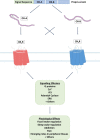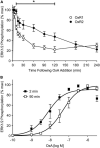Orexin Signaling: A Complex, Multifaceted Process
- PMID: 35496914
- PMCID: PMC9044999
- DOI: 10.3389/fncel.2022.812359
Orexin Signaling: A Complex, Multifaceted Process
Abstract
The orexin system comprises two G protein-coupled receptors, OX1 and OX2 receptors (OX1R and OX2R, respectively), along with two endogenous agonists cleaved from a common precursor (prepro-orexin), orexin-A (OX-A) and orexin-B (OX-B). For the receptors, a complex array of signaling behaviors has been reported. In particular, it becomes obvious that orexin receptor coupling is very diverse and can be tissue-, cell- and context-dependent. Here, the early signal transduction interactions of the orexin receptors will be discussed in depth, with particular emphasis on the direct G protein interactions of each receptor. In doing so, it is evident that ligands, additional receptor-protein interactions and cellular environment all play important roles in the G protein coupling profiles of the orexin receptors. This has potential implications for our understanding of the orexin system's function in vivo in both central and peripheral environments, as well as the development of novel agonists, antagonists and possibly allosteric modulators targeting the orexin system.
Keywords: G protein; GPCR (G protein coupled receptor); arrestin; orexin; orexin 1 receptor; orexin 2 receptor; signaling.
Copyright © 2022 Dale, Hoyer, Jacobson, Pfleger and Johnstone.
Conflict of interest statement
KP is Chief Scientific Advisor to Dimerix, of which he has a shareholding. The remaining authors declare that the research was conducted in the absence of any commercial or financial relationships that could be construed as a potential conflict of interest.
Figures


References
-
- Ammoun S., Johansson L., Ekholm M. E., Holmqvist T., Danis A. S., Korhonen L., et al. (2006a). OX1 orexin receptors activate extracellular signal-regulated kinase in Chinese hamster ovary cells via multiple mechanisms: the role of Ca2+ influx in OX1 receptor signaling. Mol. Endocrinol. 20 80–99. 10.1210/me.2004-0389 - DOI - PubMed
-
- Ammoun S., Lindholm D., Wootz H., Åkerman K. E., Kukkonen J. P. (2006b). G-protein-coupled OX1 orexin/hcrtr-1 hypocretin receptors induce caspase-dependent and-independent cell death through p38 mitogen-/stress-activated protein kinase. J. Biol. Chem. 281 834–842. 10.1074/jbc.M508603200 - DOI - PubMed
Publication types
LinkOut - more resources
Full Text Sources
Other Literature Sources

